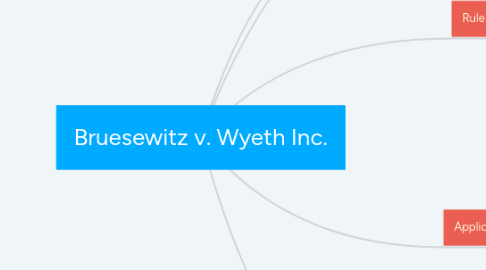
1. Facts
1.1. Parties
1.1.1. Russell Bruesewitz
1.1.2. Wyeth Inc.
1.2. What happened
1.2.1. Hannah Bruesewitz received her six-month Wyeth's Tri-Immunol DTP (diphtheria, tetanus and pertussis) vaccine in 1992
1.2.2. she started developing residual seizures within 24 hours
1.2.3. Her condition requires constant care due to the residual seizure disorder
1.3. Procedural History
1.3.1. Russell Bruesewitz filed a suit in the Vaccine Court
1.3.1.1. Case dismissed
1.3.1.1.1. Insufficient evidence of link between the vaccine and Hannah's condition
1.3.2. Then, Russell filed a suit in Pennsylvania State court
1.3.2.1. Case dismissed
1.3.2.1.1. The design defect claim was preempted by a section of the National Childhood Vaccine Injury Act of 1986
1.3.3. Third Circuit Court of Appeals
1.3.3.1. Affirmed
2. Issue before the Court
2.1. Whether the National Childhood Vaccine Injury Act (NCVIA) of 1986 provides a preemption to manufacturers from tort actions filed in federal/state court by victims/plaintiffs seeking compensation for injuries due to the vaccine's defective design
3. Rule of Law
3.1. the NCVIA preempts design defect claims against the manufacturers
3.1.1. Causation Test
3.1.1.1. Was it the best design to prevent the injury or side effects?
3.1.1.1.1. Whether the better design available at the time of the injury and the side effects or injury was not "Unavoidable". In that case, the term of "Unavodable" does not preempt the manufactures in a tort action under comment K and the Restatement Second of Torts Section 402 (a)
3.1.2. Breach of Duty Test
3.1.2.1. Was a policy exposed the children to unnecessary safety risk?
3.1.2.1.1. Whether the NCVIA preempt manufacturers from the regulatory compliance
3.1.2.1.2. Whether the plaintiffs can be protected under the State law
4. Application
4.1. Wyeth Inc argues that had Congress truly intended to preserve design-defect claims
4.1.1. The NCVIA and Vaccine court system provides the sufficient protection to plaintiff through an exhaustion requirement
4.2. Wyeth Inc argues the vaccine was the vaccine was the best model at the time and defendant did not withhold the information from FDA
4.2.1. Court believes that NCVIA does not promote the manufacturers to withdraw the product voluntarily for defect claims prior to FDA's order
4.2.2. Why?
4.2.2.1. FDA worked with the scientific community and the national Government worked with manufacturers to produce a safer vaccine
4.2.2.2. CDC worked with the scientific and medical community to ensure the public health and indepent from the manufacturers
